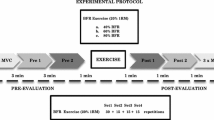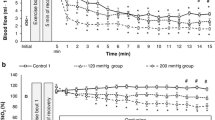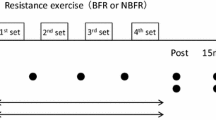Abstract
16 male subjects exercised at 25, 50, 75, 90, 100 and 120% of\(\dot V_{O_2 \max } \) on a von Döbeln bicycle ergometer. The muscle mass was measured in a whole body counter. Muscle blood flow (MBF) estimated from the rate of133Xe clearance from m. rectus femoris showed a levelling-off at about 0.5 l of blood per min and liter of muscle tissue (equal to an irrigation coefficient of 0.5 min−1) at work rates above 50 to 60% of\(\dot V_{O_2 } \). This concurs with clearance data from the literature. However, when MBF is calculated from\(\dot V_{O_2 } \), muscle mass, and reliable values for\(a - \upsilon _{O_2 }\) differences, MBF in the present subjects would: 1. Not level off before 90 to 100%\(\dot V_{O_2 \max } \), 2. reach a value of 1.0 min−1. The underestimation of MBF calculated from133Xe clearance and the levelling-off shown by this method may be due to a systematic error inherent in the method, the133Xe clearance being diffusion limited at high flow rates.
Similar content being viewed by others
References
Asmussen, E., Christensen, E. H., Nielsen, M.: Die O2-Aufnahme der ruhenden und der arbeitenden Skelettmuskeln. Skand. Arch. Physiol.82, 212–220 (1939)
Åstrand, P. O., Cuddy, T. E., Saltin, B., Stenberg, J.: Cardiac output during submaximal and maximal work. J. appl. Physiol.19, 268–274 (1964)
Åstrand, P. O., Saltin, B.: Maximal oxygen uptake and heart rate in various types of muscular activity. J. appl. Physiol.16, 977–981 (1961)
Binkhorst, R. A., Leeuwen, P. Van: A rapid method for the determination of aerobic capacity. Int. Z. angew. Physiol.19, 459–467 (1963)
Bolme, P., Edwall, L.: Dissociation of tracer disappearance rate and blood flow in isolated skeletal muscle during various vascular reactions. Acta physiol. scand.82, 17–27 (1971)
Bonde-Petersen, F., Nielsen, B., Nielsen, S. L., Vanggaard, L.:133Xe clearance from musculus quadriceps femoris during concentric and eccentric bicycle exercise at different temperatures and loads. Acta physiol. scand.80, 16–17A (1970)
Bonde-Petersen, F., Siggaard-Andersen, J.: Simultaneous venous occlusion plethysmography and Xe133 clearance in patients with arteriosclerosis of the lower extremities. An attempt to evaluate the blood flow in skin and muscle. Scand. J. thorac. cardiovasc. Surg.3, 20–25 (1969)
Clausen, J. P., Lassen, N. A.: Muscle blood flow during exercise in normal man studied by the133Xenon clearance method. Cardiovasc. Res.5, 245–254 (1971)
Conn, H. L.: Equilibrium distribution of radioxenon in tissue: Xenon-hemoglobin association curve. J. appl. Physiol.16, 1065–1070 (1961)
von Döbeln, W.: A simple bicycle ergometer. J. appl. Physiol.7, 222–224 (1954)
von Döbeln, W.: Determination of body constitutions. In: Symposia of the Swedish nutrition foundation. II. Occurence, causes and prevention of overnutrition (G. Blix, Ed.). Uppsala: Almquist & Wiksell 1964
Gollnick, P. D., Piehl, K., Saltin, B.: Selective glycogen depletion pattern in human muscle fibres after exercise of varying intensity and at varying pedal rates. J. Physiol. (Lond.)241, 45–57 (1974)
Grimby, G., Häggendal, E., Saltin, B.: Local Xenon133 clearance from the quadriceps muscle during exercise in man. J. appl. Physiol.22, 305–310 (1967)
Henriksson, J., Bonde-Petersen, F.: Integrated electromyography of quadriceps femoris muscle at different exercise intensities. J. appl. Physiol.36, 218–220 (1974)
Hermiston, R. T., Bonde-Petersen, F.: The influence of varying oxygen tensions in inspired air on133Xe muscle clearance and fatigue levels during sustained and dynamic contractions. Europ. J. appl. Physiol. (1975, to be submitted)
Hirzel, H. C, Krayenbuehl, H. P.: Validity of the133Xenon method for measuring coronary blood flow. Comparison with coronary sinus outflow determined by an electromagnetic flowprobe. Pflügers Arch.349, 159–169 (1974)
Hoes, M. J. A. J. M., Binkhorst, R. A., Smeekes-Kuyl, A. E. M. C, Wissers, A. C. A.: Measurements of forces exerted on pedal and crank during work on a bicycle ergometer at different loads. Int. Z. angew. Physiol.26, 33–42 (1968)
Holzman, G. B., Wagner, H. N., Iio, M., Rabinowitz, D., Zierler, K. L.: Measurements of muscle blood flow in the human forearm with radioactive Krypton and Xenon. Circulation30, 27–34 (1964)
Jorfeldt, L., Wahren, J.: Leg blood flow during exercise in man. Clin. Sci.41, 459–473 (1971)
Kety, S. S.: Measurement of regional circulation by the local clearance of radioactive sodium. Amer. Heart J.38, 322–328 (1949)
Kjellmer, I., Lindbjerg, I., Prérovský, I., Tønnesen, K. H.: The relation between blood flow in an isolated muscle measured with the Xe133 clearance and a direct recording technique. Acta physiol. scand.69, 69–78 (1967)
Lassen, N. A., Lindbjerg, I. F., Munck, O.: Measurement of blood flow through skeletal muscle by intramuscular injection of133Xenon. Lancet1964 I, 686–689
Lindbjerg, I. F., Andersen, A. M., Munck, O., Jørgensen, M.: The fat content of leg muscles and its influence on the133Xenon clearance method of blood-flow measurements. Scand. J. clin. Lab. Invest.18, 525–534 (1966)
Pernow, B., Wahren, J., Zetterquist, S.: Studies on the peripheral circulation and metabolism in man. IV. Oxygen utilization and lactate formation in the legs of healthy young men during strenuous exercise. Acta physiol. scand.64, 289–298 (1965)
Pirnay, F., Marechal, R., Radermecker, R., Petit, J. M.: Muscle blood flow during submaximum and maximum exercise on a bicycle ergometer. J. appl. Physiol.32, 210–212 (1972)
Rowell, L. B.: Human cardiovascular adjustments to exercise and thermal stress. Physiol. Rev.54, 75–159 (1974)
Wahren, J., Saltin, B., Jorfeldt, L., Pernow, B.: Influence of age on the local circulatory adaptation to leg exercise. Scand. J. clin. Lab. Invest.33, 79–86 (1974)
Author information
Authors and Affiliations
Additional information
This study was supported by a grant from the Swedish Medical Council and from Statens lægevidenskabelige forskningsråd, Denmark, project no 512–667 and 512–1156.
Rights and permissions
About this article
Cite this article
Bonde-Petersen, F., Henriksson, J. & Lundin, B. Blood flow in thigh muscle during bicycling exercise at varying work rates. Europ. J. Appl. Physiol. 34, 191–197 (1975). https://doi.org/10.1007/BF00999932
Received:
Issue Date:
DOI: https://doi.org/10.1007/BF00999932




